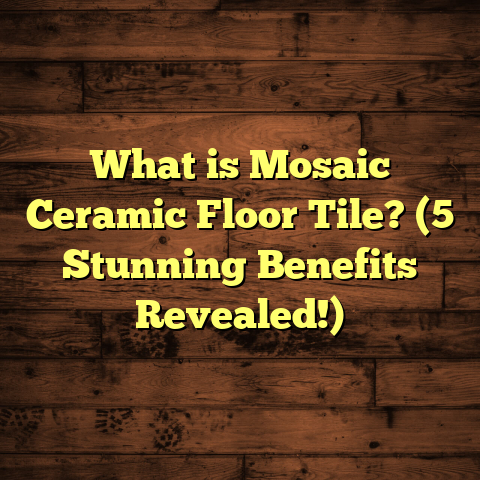What Is Glazed Floor Tile? (5 Benefits for Stunning Interiors)
Sustainability has become a big part of how I think about home improvement. When I first started working in flooring, my main focus was style and durability, but over time, I realized that choosing materials that are kinder to the planet matters just as much. That’s why glazed floor tiles caught my attention—they combine beauty with long-lasting performance and can even contribute to a more eco-friendly home. Let me share what I’ve learned about them and why they could be a great choice for your interiors.
What Is Glazed Floor Tile?
So, what exactly is glazed floor tile? In simple terms, it’s a ceramic or porcelain tile that has been coated with a glass-like surface layer called glaze. This glaze is baked onto the tile at very high temperatures during manufacturing. That process creates a smooth, often shiny finish that protects the tile and allows for a wide range of colors, patterns, and textures.
The tile underneath the glaze is usually made from natural clay or a mix of minerals. The glaze itself is made by mixing silica, fluxes, and colorants, which melt during firing to form a durable coating. This layer not only makes the tile look stunning but also adds a protective shield against water, stains, and wear.
From my experience, the glaze on these tiles can vary quite a bit—from glossy and reflective to matte or textured finishes. This variety makes glazed tiles super versatile because you can match them with almost any design style.
Types of Glazed Tiles I’ve Worked With
- Ceramic glazed tiles: These are usually lighter and great for indoor use.
- Porcelain glazed tiles: Denser and more water-resistant, perfect for floors that get heavy foot traffic or even outdoor use.
- Polished glazed tiles: Very shiny and modern looking but might be slippery.
- Matte glazed tiles: More subtle finish with less shine but still easy to clean.
Working with different types has taught me that knowing the right kind for your space can make all the difference in both appearance and durability.
Why Do I Recommend Glazed Floor Tiles? 5 Benefits You’ll Love
I’ve installed glazed floor tiles in many homes and commercial spaces, and there are five benefits that always stand out for me:
1. They’re Super Durable — Tough Enough to Last
Glazed floor tiles hold up incredibly well under pressure. The glaze layer acts like armor against scratches, dents, and stains. According to industry data, glazed porcelain tiles have a water absorption rate of less than 0.5%, making them highly resistant to moisture damage compared to unglazed tiles which can absorb up to 3-7%.
In one of my recent projects with a client who had kids and pets running around constantly, we chose matte glazed porcelain tiles for the kitchen and living room. After a year, the tiles still looked brand new despite daily spills and heavy use. That durability means fewer replacements and less waste—something I always appreciate from a sustainability standpoint.
2. Endless Design Possibilities — Style Without Limits
Have you seen how many patterns and colors glazed tiles come in? I once saw a showroom wall covered in floral glazed tiles that looked like ceramic paintings. It got me thinking about how art meets function here.
The glazing process allows manufacturers to add intricate details and vibrant colors that don’t fade easily. Whether you want classic subway tiles, bold geometric patterns, or rustic stone looks, there’s something for every mood and décor style.
In fact, the global market shows that decorative glazed tiles are among the fastest-growing segments in flooring materials because homeowners want unique aesthetics without sacrificing quality.
3. Easy to Maintain — Less Time Cleaning Means More Time Enjoying
Glazed floor tiles are some of the easiest floors to keep clean. The smooth glazed surface doesn’t trap dirt or grime like porous materials do. For me, this has always been a selling point when clients ask about low-maintenance options.
I remember helping an elderly couple pick out flooring; they needed something both attractive and simple to care for. Glazed tiles fit perfectly because they only require regular sweeping and occasional mopping with mild detergent to stay fresh.
Plus, because they resist stains so well, you don’t have to worry about red wine or coffee spills ruining your floors.
4. Hygienic and Allergy-Friendly — A Breath of Fresh Air Indoors
If you or someone in your family struggles with allergies or respiratory issues, glazed floor tiles can help create a cleaner environment. Unlike carpets or some wood floors, glazed tiles don’t harbor dust mites, pet dander, or mold.
Scientific studies show that hard flooring surfaces like glazed tiles reduce airborne allergens significantly compared to soft surfaces. This makes them ideal for bedrooms, kitchens, or bathrooms where hygiene is a top priority.
I’ve personally recommended glazed tiles for clients with asthma sufferers, and they’ve shared how much easier it is to breathe in their homes after switching from carpeted floors.
5. Cost-Effective Over Time — Looks Great Without Breaking the Bank
While some types of glazed tiles might seem pricier upfront compared to laminate or vinyl options, I always encourage people to think about the long-term savings. Because they last so long and require minimal maintenance, they often cost less over time.
My research on flooring costs showed that glazed porcelain tiles have an average lifespan of 20-30 years when installed properly. On the other hand, cheaper alternatives may need replacement every 7-10 years.
Also, many suppliers now offer eco-friendly glazed tiles made with recycled materials or sustainable manufacturing processes, making them budget-friendly and earth-friendly at the same time.
How Glazed Tiles Fit Into Sustainable Flooring Choices
When I first got interested in sustainable building practices, I dug into how different flooring types impact the environment. Glazed floor tiles stood out because:
- Their base materials like clay are abundant and naturally sourced.
- The firing process uses energy efficiently in modern kilns.
- High durability means less frequent replacement.
- Many manufacturers recycle broken tile pieces back into production.
- Some glazes are now formulated without harmful chemicals like lead or cadmium.
To back this up, a case study from a European manufacturer showed that glazed porcelain tile production emits around 30% less CO2 than traditional ceramic tile production methods due to improved energy recovery systems used in their kilns.
During installations, I also make sure to calculate waste accurately to avoid ordering too much material. Tools like FloorTally help me estimate extra tiles needed for cuts and breakage without overspending or creating excess landfill waste.
Real-Life Story: My Experience Installing Glazed Tiles in a Coastal Home
Last summer, I worked on a project for a family renovating their beach house. They wanted floors that could handle salty air and occasional moisture from wet feet but still bring warmth inside.
We chose large-format glazed porcelain tiles with a textured matte finish for slip resistance. The glaze protected against staining from sand and water while looking like natural stone.
The homeowners were thrilled with how easy it was to clean sandy footprints every day—just a quick sweep or mop—and how the floor kept its charm despite heavy use.
This project reinforced my belief that glazed floor tiles aren’t just beautiful—they’re practical solutions for real-life challenges.
Tips From My Toolkit: Choosing the Right Glazed Tiles for Your Home
Here are some things I’ve learned over the years that might help you pick the best glazed floor tile:
- Consider foot traffic: Porcelain options are better for busy areas because they’re harder and more water-resistant.
- Finish matters: Glossy tiles are stunning but can be slippery; matte or textured finishes offer better grip.
- Color choice: Light colors brighten spaces but show dirt more easily; darker shades hide imperfections better.
- Size & layout: Larger tiles create a modern look with fewer grout lines; smaller mosaics add charm but can require more maintenance.
- Grout selection: Use stain-resistant grout to keep things looking fresh longer.
If you’re unsure what suits your space best, don’t hesitate to ask for samples or visit showrooms to see how different glazed tiles feel underfoot in natural light.
Installation Insights: What I’ve Learned From Laying Glazed Tiles
Installing glazed floor tile isn’t as straightforward as just laying down the pieces. I’ve been involved in quite a few installations over the years, so here are some tips from my experience:
Surface Preparation Is Key
One time, I arrived at a job where the subfloor wasn’t properly leveled. The client wanted glossy glazed tiles in their dining room. Because of uneven surfaces beneath, some tiles eventually cracked after installation. Since glazed tiles can be brittle if stressed unevenly underneath, making sure your subfloor is flat is critical.
Before installation:
- Clean away debris.
- Level any bumps or dips.
- Check moisture levels (especially on concrete).
Failing to do these can cause grout cracking or tile chipping down the line.
Use Quality Adhesives
I always recommend using high-quality thin-set mortar designed specifically for porcelain or ceramic tiles. The adhesive needs to bond well but also allow some flexibility since floors expand slightly with temperature changes.
In one renovation project involving an open-plan kitchen/living area with radiant heating beneath the floor, choosing the right adhesive was crucial to prevent tile loosening due to heat cycles.
Spacing & Grout Lines Matter
Glazed tiles come in various sizes—from tiny mosaics to large slabs. My advice is not to skimp on grout lines; even if you want sleek looks with narrow joints (like 1/16 inch), leaving at least a small gap helps accommodate movement and reduces cracking risks.
Grout color also affects overall appearance—matching grout closely with tile helps create seamless looks; contrasting grout can emphasize patterns.
Sealing After Installation?
You might wonder if glazed floor tiles need sealing. Generally speaking:
- The glaze itself forms a waterproof barrier.
- Porcelain glazed tiles usually don’t require sealing.
- However, grout lines do need sealing to prevent staining and water penetration.
I always seal grout within a week of installation as part of finishing touches.
Maintenance Stories: Keeping Glazed Floors Beautiful Over Time
Maintaining glazed floor tile is pretty straightforward compared to many other flooring types I’ve worked with.
Cleaning Routines That Work
For daily upkeep:
- Sweep or vacuum regularly to remove dust.
- Mop weekly with warm water mixed with pH-neutral cleaner specifically for tile floors.
Avoid harsh chemicals like bleach or ammonia-based cleaners which can dull glaze over time.
Stain Removal Tips
Spills happen—coffee mugs tip over or red wine splashes—but thanks to glazing’s stain resistance:
- Wipe spills promptly with soft cloths.
- For stubborn stains (like grease), gentle scrubbing with baking soda paste works wonders.
I once had a client spill motor oil on their garage tiled floor—because it was glazed porcelain—cleaning it up was much easier than they expected.
Repairing Chips or Cracks
Although durable, accidents can chip edges if heavy objects fall on them. When this happens:
- Small chips can sometimes be filled with epoxy fillers matched to tile color.
- For bigger damage, replacing individual tiles is usually necessary.
I keep spare tiles from each project just in case clients need repairs years later—it saves hassle down the road.
Comparing Glazed Floor Tile With Other Popular Flooring Options
Wondering how glazed floor tile stacks up against alternatives? Here’s what I’ve seen working side-by-side:
| Flooring Type | Durability | Maintenance | Cost Range | Eco-Friendliness | Style Flexibility |
|---|---|---|---|---|---|
| Glazed Floor Tile | Very high | Easy | Moderate – High | Good (recyclable) | Excellent |
| Hardwood | High (can scratch) | Moderate (refinishing) | Moderate – High | Renewable resource | Excellent |
| Laminate | Moderate | Easy | Low – Moderate | Less eco-friendly | Good |
| Vinyl | Moderate | Easy | Low | Poor (PVC content) | Good |
| Carpet | Low – Moderate | Difficult | Low – Moderate | Poor (synthetic) | Good |
From my perspective:
- Hardwood floors offer warmth and timeless appeal but need more care.
- Vinyl is budget-friendly but doesn’t last as long and often isn’t eco-conscious.
- Carpet can trap allergens and dirt more than glazed tile does.
If you prioritize durability and low maintenance while keeping design options wide open, glazed floor tile is tough to beat.
Frequently Asked Questions I Get About Glazed Floor Tile
Having installed these tiles hundreds of times, I often get asked:
Q: Can glazed floor tile be used outdoors?
A: Yes! Porcelain glazed tiles especially are great outdoors because they resist moisture well. Just pick those rated for exterior use with slip-resistant finishes.
Q: Are glazed floor tiles slippery?
A: It depends on the finish. Polished/glossy ones can be slippery when wet; matte or textured finishes improve grip significantly.
Q: How do I avoid cracks during installation?
A: Proper subfloor prep and using quality adhesives go a long way. Also avoid walking on freshly laid tiles before curing time completes (usually 24–48 hours).
Q: Can I install over existing flooring?
A: Sometimes yes—for example over concrete slabs—but over wood floors usually not recommended unless reinforced due to weight.
Q: How long does installation take?
A: For average rooms (200–300 sq ft), professional installers typically need 2–3 days including prep and grout drying.
Personal Reflections: Why I Keep Recommending Glazed Floor Tiles
Over many years working as a flooring contractor, I keep coming back to glazed floor tile because it checks so many boxes:
- It’s beautiful—adds character whether modern or traditional.
- It’s practical—stays looking good even in tough conditions.
- It’s sustainable—with natural materials that last decades.
- It’s easy on homeowners—saving time on cleaning means more time enjoying life indoors.
Plus, seeing clients’ faces light up when their new floors come together never gets old. One memorable moment was when a young couple showed me photos of their toddler happily crawling on their new matte-finish porcelain floor—clean spills easily wiped away without worry. Moments like that remind me why these floors matter beyond just aesthetics.
Exploring Innovations in Glazed Tile Technology
The tile industry isn’t standing still either. I’ve noticed exciting trends pushing glazed tile further:
- Nano-glazing: Some manufacturers now add nano-coatings that repel water and stains even better than traditional glaze.
- Eco-conscious glazing: New formulations avoid heavy metals and use plant-based pigments reducing environmental impact.
- Larger formats: Tiles as big as 48″x48″ minimize grout lines and create seamless floors that feel expansive.
- Textured glazes: Mimicking wood grain or natural stone textures for those who want organic looks combined with tile durability.
These innovations make me optimistic about future flooring options being even more beautiful and responsible choices.
Case Study: Office Renovation Using Glazed Porcelain Tiles
A commercial client once hired me to redo their office lobby flooring where foot traffic was extreme—hundreds of people daily coming in from outside shoes and weather elements.
We chose high-quality polished glazed porcelain tiles rated PEI 5 (Porcelain Enamel Institute rating for surface hardness), ensuring top-notch wear resistance.
After two years:
- No visible wear marks appeared.
- Cleaning crews reported less effort needed compared to old carpeted floors.
- The company saved on maintenance costs by 40% annually versus their previous flooring.
This case convinced me even more how effective glazed floor tile is not just residentially but commercially too.
Breaking Down Costs: What You Should Expect When Buying Glazed Floor Tile
I know budgets are critical for every project. Here’s what typical cost components look like based on recent market research combined with my hands-on quotes:
| Item | Average Cost Range |
|---|---|
| Glazed ceramic tile | $1 – $5 per sq ft |
| Glazed porcelain tile | $3 – $10 per sq ft |
| Installation labor | $4 – $8 per sq ft |
| Grout and materials | $0.50 – $1 per sq ft |
| Additional supplies (adhesive/sealant) | $0.50 – $1 per sq ft |
So for an average-sized kitchen of 150 square feet:
- Total cost might range between $1,200 – $3,000 including materials & labor depending on tile choice.
Keep in mind:
- Higher-end designer tiles or large formats cost more upfront but last longer.
- DIY installation saves labor costs but requires skill and tools.
Being realistic about your budget helps make smart decisions without surprises later on.
Environmental Impact: How Choosing Glazed Tiles Can Help Reduce Your Carbon Footprint
Using data from lifecycle assessments (LCA), manufacturers estimate that:
- Producing one square meter of porcelain glazed tile releases approximately 15–20 kg CO2 equivalent emissions.
- Compared to engineered hardwood flooring which can emit around 25–30 kg CO2 per square meter due to processing & finishes involved.
Because of durability (lasting decades) and recyclability at end-of-life stages, glazed floor tile often scores well environmentally versus disposable alternatives like vinyl or laminate which contain plastics that persist long-term in landfills.
By opting for locally sourced clay-based tiles manufactured using energy-efficient kilns—as many brands now do—you contribute less greenhouse gas emissions compared to imported products shipped thousands of miles by truck or ship.
How To Pair Glazed Floor Tiles With Other Interior Elements For Stunning Results
I love helping clients mix textures and colors that complement their new tiled floors. Here’s what works best based on my years of trial:
Walls & Paint Colors
Neutral walls let patterned or brightly colored glazed tiles shine without overwhelming rooms. Soft whites or warm grays harmonize nicely with most hues found on tile surfaces.
Furniture Choices
For shiny polished floors: matte-finished wood furniture balances glossiness nicely creating contrast versus too much shine everywhere.
For matte textured floors: smooth leather chairs or glass tables introduce different tactile experiences making rooms feel layered but cohesive.
Rugs & Accessories
Area rugs soften spaces visually while protecting high traffic zones even on durable floors—especially useful around sofas or dining tables where chairs slide often.
Throw pillows or curtains picking up accent colors from your tile pattern tie everything together effortlessly.
Wrapping Up My Thoughts on Glazed Floor Tiles
After years of installing various flooring materials, I can say that glazed floor tiles have earned a special place in my toolkit. They blend style with strength, offer plenty of design freedom, and fit well with sustainable living goals.
If you’re aiming for floors that look great year after year without much hassle—and want something that’s kind to the environment—glazed floor tile is definitely worth exploring. Have you tried it before? Or maybe you’re thinking about it now? I’d love to hear what appeals most to you about glazed tiles!





